After 150 issues spread over 13 years, the grand comic that is Fables has finally come to an end.
For those of you not in the know Fables is a comic series written by Bill Willingham that started in 2002 and ended last month. It is the last of the zeitgeist-changing Vertigo comics titles that include Sandman, Swamp Thing, Hellblazer, Preacher, and Y: The Last Man. There have been numerous crossovers, spin-offs, a novel and even a critically acclaimed video game.
In other words, covering Fables and all its spin-offs is a massive undertaking — which is why I will, unfortunately, be joined by our friend the “Disembodied Voice That Haunts Kotaku Writers Whenever We Do Explainer Articles.”
Nice to be appreciated. I seem to remember the last time we talked you kicked me out.
And yet here we are. Oh, and while I know you and Fahey have talked before about what Fables is (which you, dear reader, should check out as well), do me a favour and play dumb, ok?
::Sigh:: Fine. So what’s the Fables thing about?
You know fairy tales?
Yeah?
They’re all real.
…what?
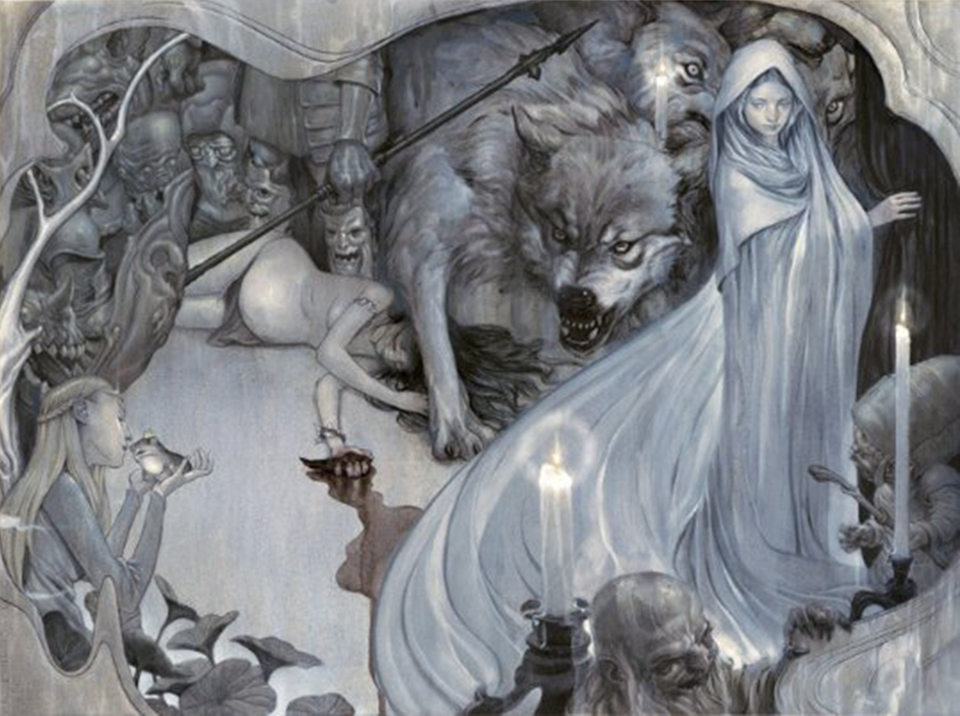
All of them. Every folk and fairy tale — be that Mother Goose, Brothers Grimm, Hans Christian Andersen, Arabian Nights — you name it.
So… Red Riding Hood, Aladdin, Puss in Boots, Cinderella? Things like that?
Yup. But not just those. King Arthur, Dracula, Paul Bunyan, Mowgli, even the Three Blind Mice — pretty much every tall tale or legend as well. All these stories really happened and their characters are real people — or rather, they were real people known as “Fables.”
“Were?”
Well, you know multiverse theory? That there are infinite parallel universes out there?
That doesn’t seem to answer my question, but, yes, I did watch Sliders growing up.
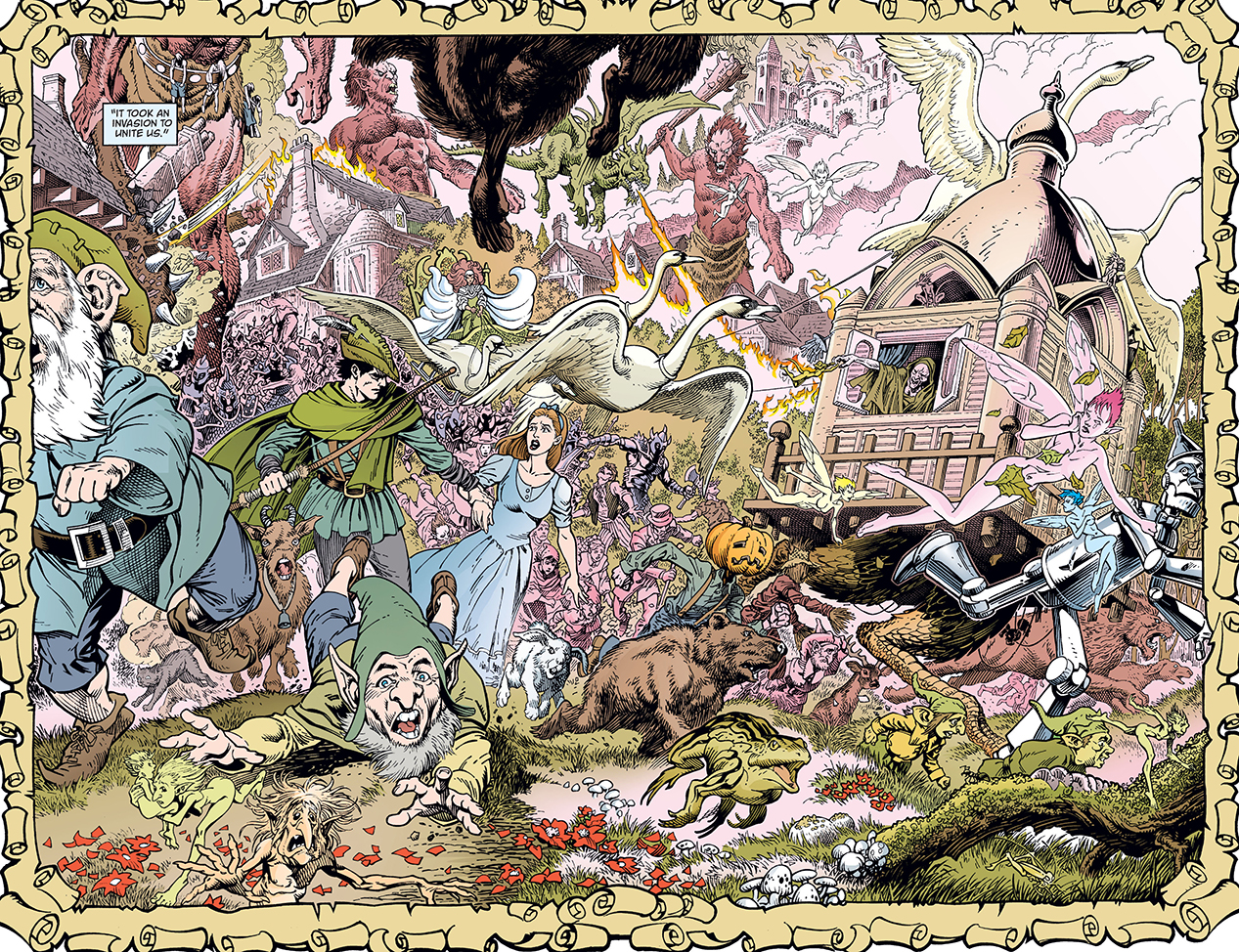
Bear with me. The fairy tales and legends we all know and love happened in various worlds across countless realities — collectively known as the “Homelands.” However, one day, a mysterious villain known only as “The Adversary” appeared with an unstoppable army and began conquering Fable worlds one after another.
And any who resisted were killed?
That’s pretty much the long and the short of it. However, when it became obvious that nothing would be able to stop The Adversary, a few hundred of the remaining free Fables came up with a desperate plan: to hide in a world The Adversary would never even want — a world so boring and utterly mundane that magic doesn’t even exist there.
…You mean our world, don’t you?
Yup.
Classy.
Anyway, the Fables arrived in our world about 400 years ago, settled in what would become New York City, and have lived there in their own little community, “Fabletown,” ever since.
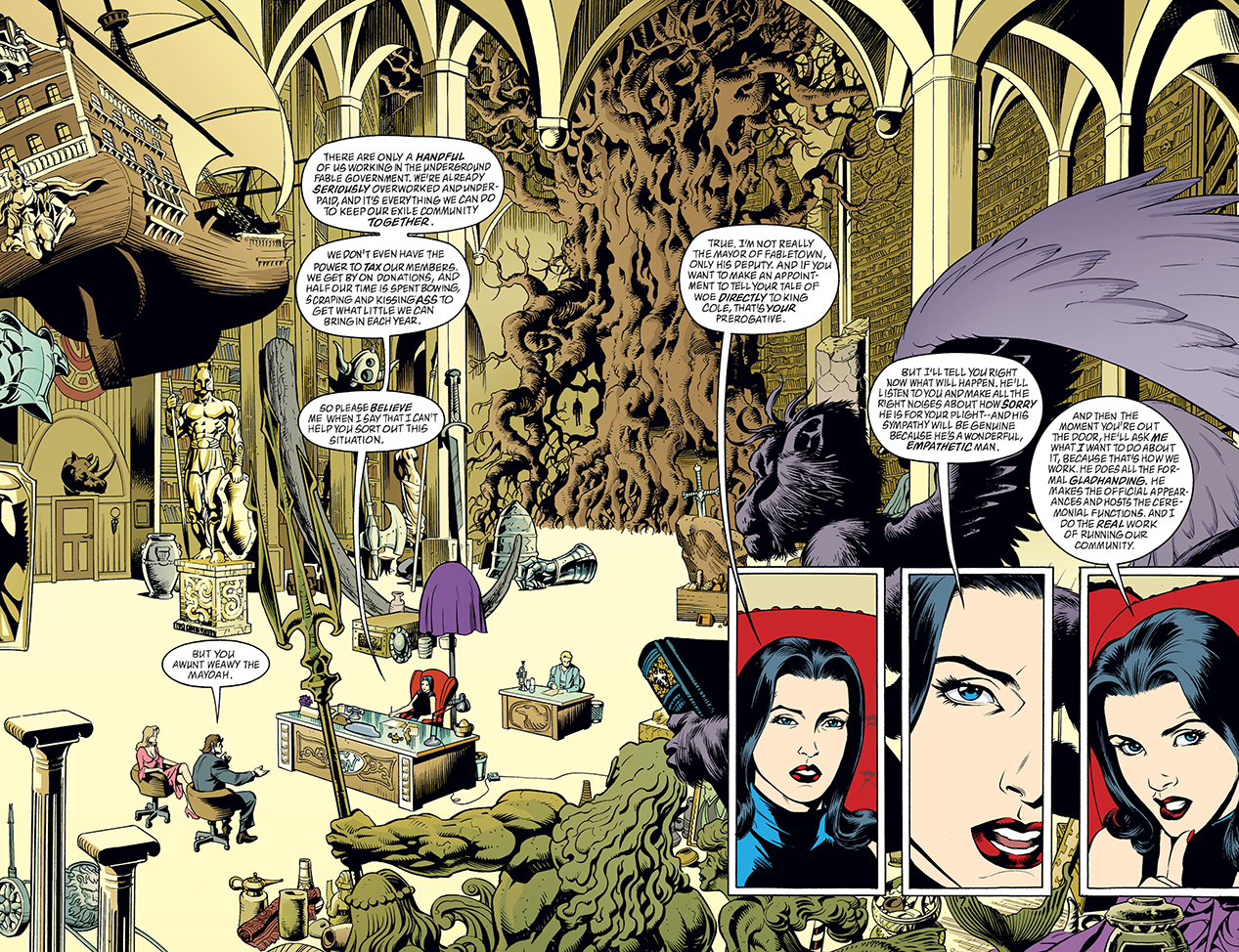
Wait… Did you — Did you just spoil the entire story?
Hahahahaha. No. That, my friend, is the backstory — the setting for Fables. The real story of Fables is yet to come.
Wow. Um. So back to the original question, then: What is Fables?
Told you that was a big question. Fables is the story of these legends living in the modern day, trying to keep their small community of immortals happy while keeping themselves secret from the “Mundy World.”
Alright. Sounds like a solid setup. Who are the main characters?
While it’s very much an ensemble cast, if there is a main character, it’s Bigby Wolf —
Wait, “Bigby Wolf?” …as in “The Big Bad Wolf?” Are you serious?
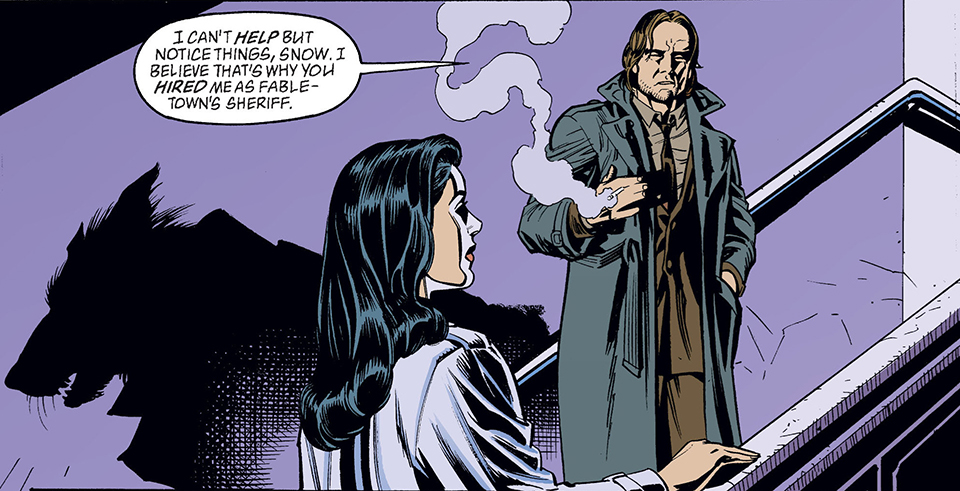
Very much so. Reformed from his big bad ways for centuries, Bigby serves as the sheriff of Fabletown — though in human form most of the time. However, despite being a pretty good guy and a decent sheriff, many Fables still treat him as the “evil creature” he once was. The only people who don’t fear him are Snow White, Cinderella, and the janitor (the Frog Prince) — oh and one of the three little pigs that seems to be constantly crashing at Bigby’s place.
Hah! Really?
Yep. But the cool thing about Bigby is that he is so much more than that. Bigby is not just the Big Bad Wolf of The Three Little Pigs or of Little Red Riding Hood — he is the menacing wolf of all fairy tales. He’s also an intricate part of werewolf and Wolfman legends.
Wait, what? …No, on second thought, I’m going to let that one go.
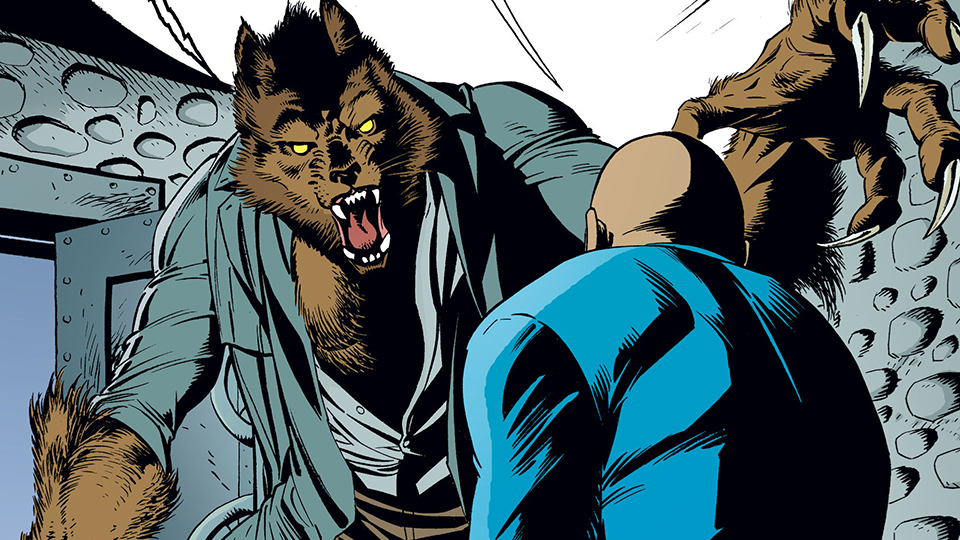
Yeah, it’s kind of a long story. Of course, he’s not the only character like this. Snow White is both characters of that name: the one from Snow White and the Seven Dwarfs and Snow-White and Rose-Red. And in a stroke of ironic genius, Prince Charming is all prince charmings — meaning he is the ex-husband of Snow White, Sleeping Beauty, and Cinderella. They don’t like him very much.
Scum of the earth, I bet?
Totally. But one of the great things about Fables is how complex the characters are. No one is one-dimensional. Prince Charming, for example, is a user. He seduces women left and right, and then he uses them for a place to crash until he is bored. Then he moves on to the next.
Yet, underneath his scuminess is actually a fair amount of self-awareness — and it’s that which, over the course of the series, compels him to be a better man. I mean, he’s still a womanizing arse, but he does work hard to be more than that.
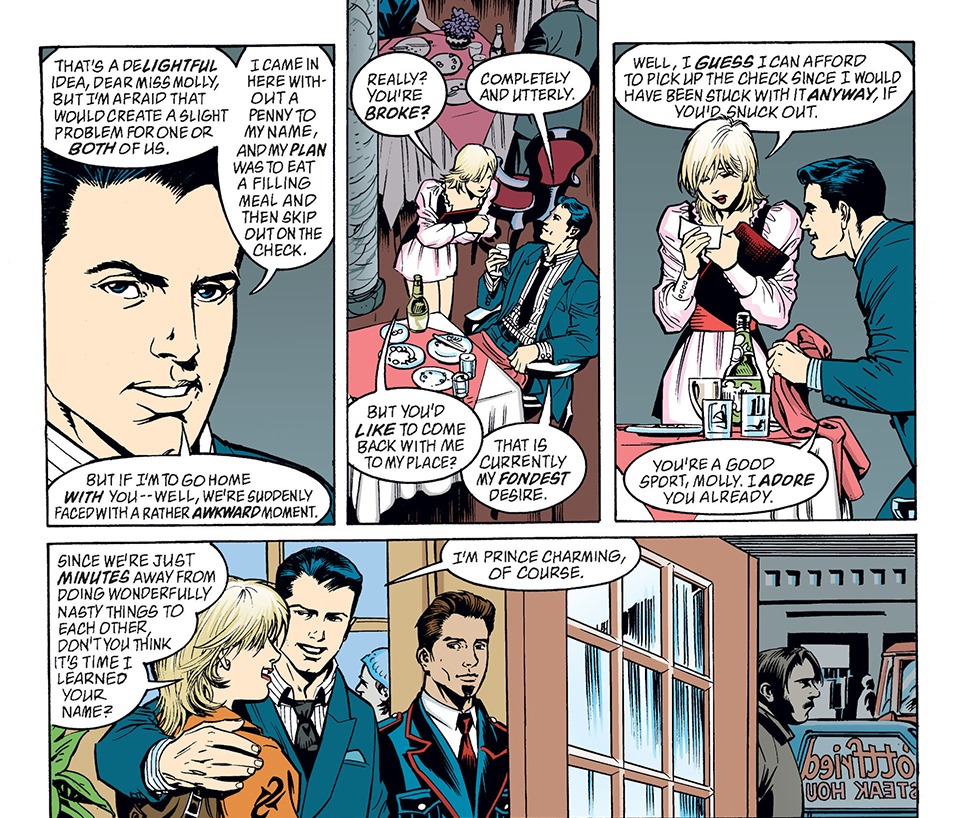
The villains, especially The Adversary, are likewise well-built. He doesn’t see himself as villainous conqueror. In his own mind, he is the hero of the story — saving the worlds of the Homelands from their own chaotic magical nature.
So all the characters are well-thought-out then?
More than that, actually. They are dynamic. Each changes based on the experiences they undergo throughout the series. Heroic or villainous, no one is the same by the end.
That sounds pretty fantastic, actually.
It is. Another interesting note is the relationship between the Fables and our plane of reality. While there is no magic in our world, the Fables themselves are powered by how well we know their stories.
What do you mean by that?
Frankly, the more famous a Fable is, the more powerful he or she is. Those like Bigby have increased strength, healing, and resilience. The magic wielding ones have that plus more magic to throw around.
Huh.
To put it another way, if you have a Disney movie made about you, you’re pretty damned hard to kill.
Well, that clears that up.
Don’t be fooled though. Just because they are hard to kill, that doesn’t mean they can’t be killed. The life and death stakes are often present, even if some Fables are a bit more resilient than others. It’s actually a great little trick when you think about it. You know what it takes to kill a human. But a Fable? You’re never really sure if they’re famous enough to live through the damage they take.
So we’ve covered the setting and characters, but how’s the story?
Fantastic. Much of Fables revolves around the interpersonal relationships of the Fabletown Fables, but each story arc expands the world and conflicts therein. The first arc is a “who done it” mystery, where Bigby has to hunt down the murderer of Rose Red, Snow White’s estranged sister.
The second arc, on the other hand, is an espionage thriller where the Animal Fables, living in a second Fabletown called “The Farm” in upstate New York, start a violent rebellion which threatens to reveal the existence of Fables to the world.
The third arc is a caper story where the Fables have to figure out what to do with a reporter who has been investigating them. It’s good stuff.
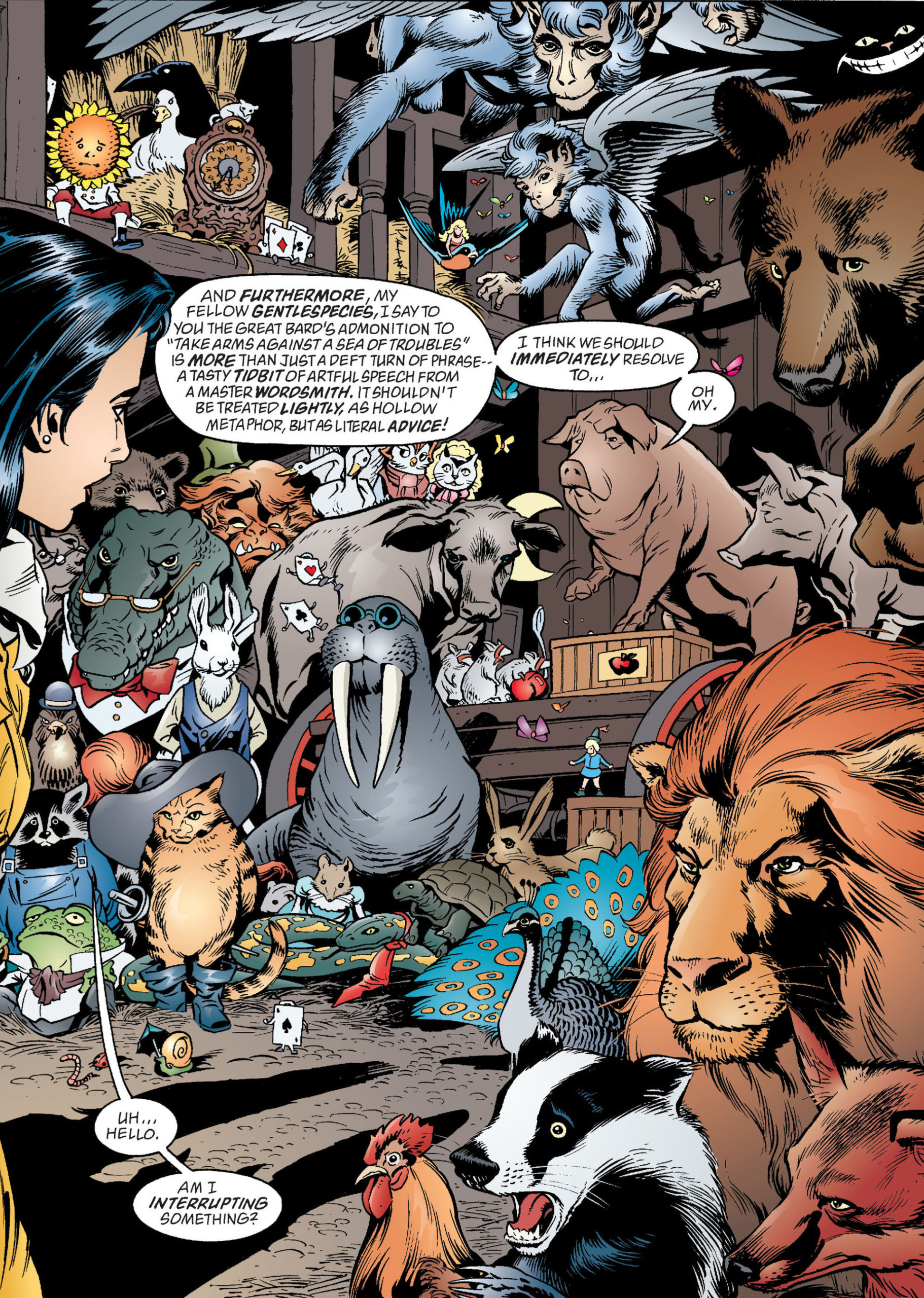
So, that takes up 150 issues?
Oh dear god no. All that takes place in the first 13.
Wow. So is it great from start to finish?
I don’t know if I’d go that far. The series really hits its peak and logical conclusion point at about issue 76.
So after the halfway point, it’s crap?
Most certainly not! But I would hazard that it never reaches the highs of the first half. That in no way makes it a bad read, however. The worst issue of Fables is on par with any “good” issue of a mainstream comic.
As the mantra of the whole series is that there are no happily ever afters, just happy moments, it makes sense for the series to continue. The biggest problem is that of the two big villains of the second half, only one seems credible and interesting — despite the other being easily the most powerful villain in the series.
That’s kind of vague.
To put it another way, personal conflicts with meaningful consequences are always more interesting that stupidly powerful bad guys.
Can’t argue with that.
Well, you can, you’d just be wrong.
Touché. So who should read Fables? Kids?
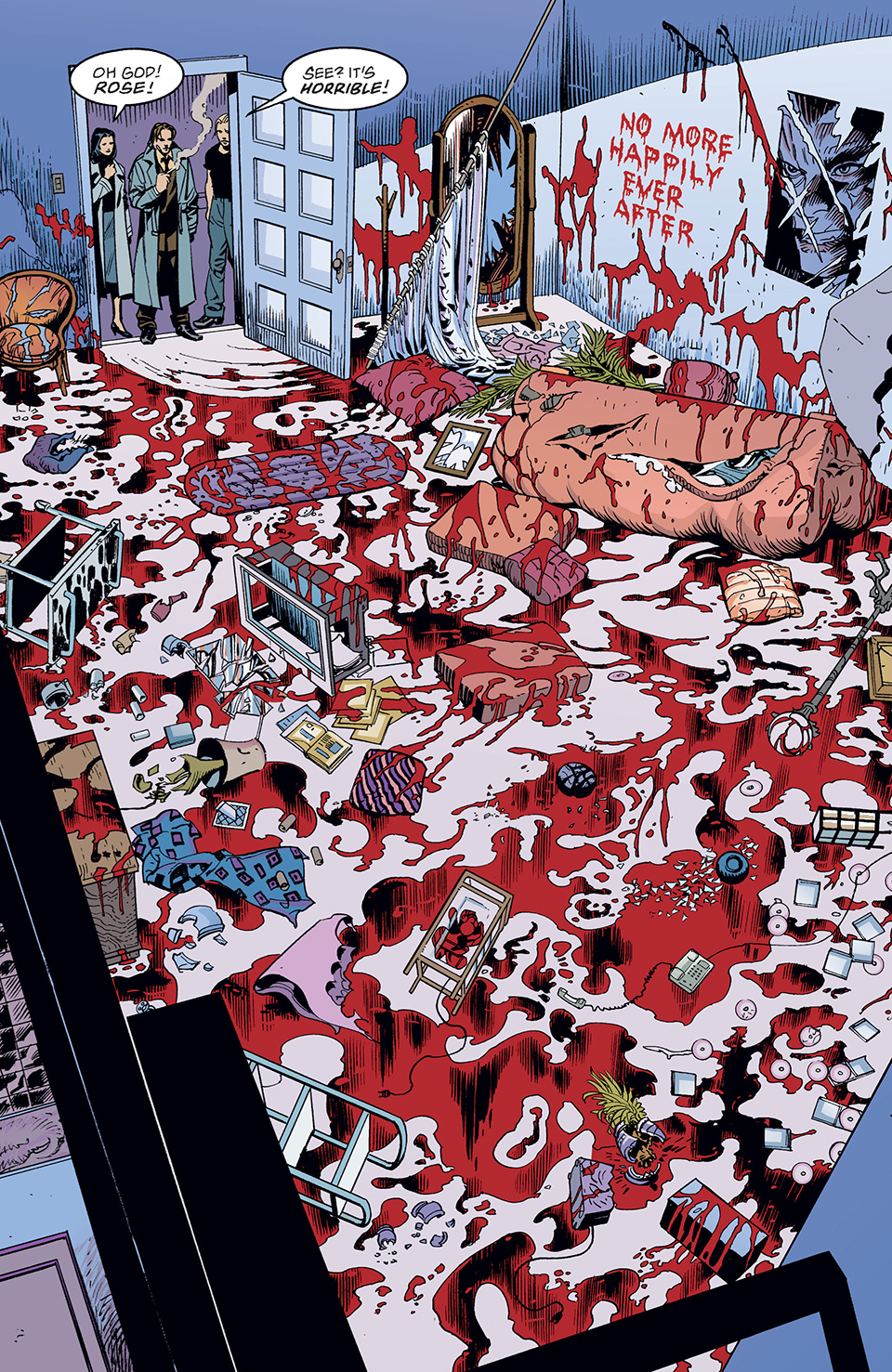
Only if you’re ok with them seeing lots of graphic violence along with sex and full-on nudity.
So adults-only then. Got it.
Yeah. It can be a pretty dark story at times. Rape, torture, and murder do come up several times throughout the series — especially when it comes to the characters’ fairy tale backstories. The Grimm brothers would be proud.
Alright, so I feel like I got a handle on the main Fables series. But you mentioned spin-offs?
Oh yeah. There are more than a few. Let’s start with the 50-issue long Jack of Fables.
“Jack” as in “and the Beanstalk?”
And Little Jack Horner and Jack and Jill — like with the others I mentioned, he’s all the “Jack” fairy tale characters in one.
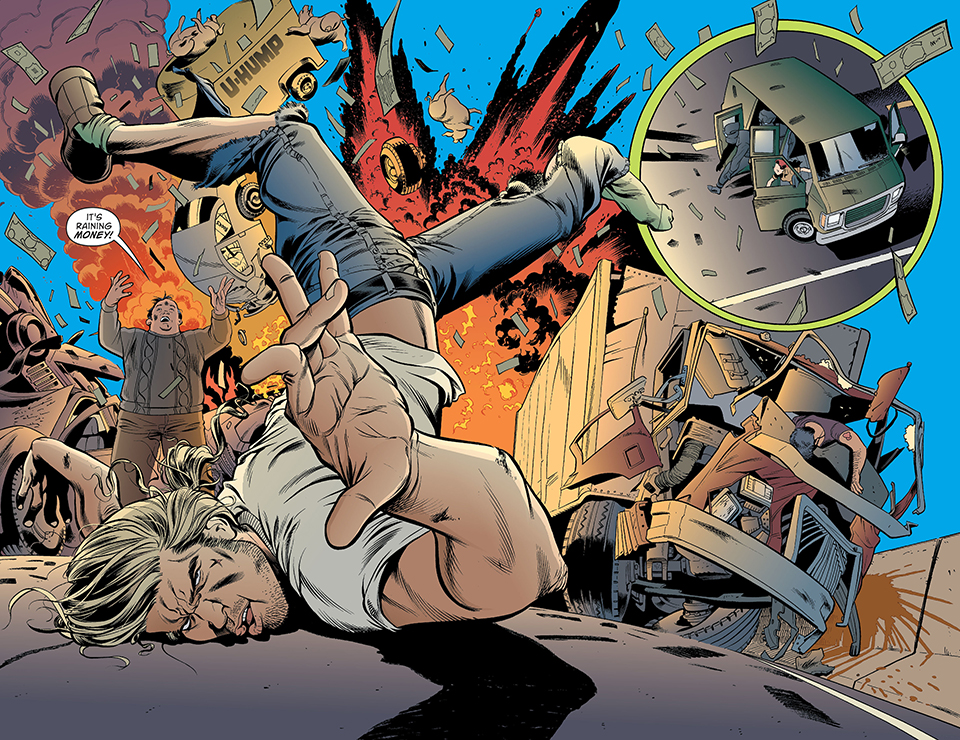
Without spoilers, let’s just say he leaves Fabletown at some point in the main story and has many misadventures of his own. He’s kinda a screw up.
How’s Jack of Fables compare to the core series?
While I think parts of it are quite fun, I’d never call it good.
Really?
Fables is, in general, a gritty, realistic series focusing on human drama. Jack of Fables, on the other hand, is just this side of slapstick humour with fourth wall-breaking moments and a focus on comedy. So it’s a loose fit at best.
Also, Jack is an arsehole; so it’s pretty hard to root for him.
Ah. So not a “must read” then.
Nope. I mean, it’s not terrible or unreadable, but it is pretty inconsequential (outside of a crossover with the main book) — especially the series’ ending.
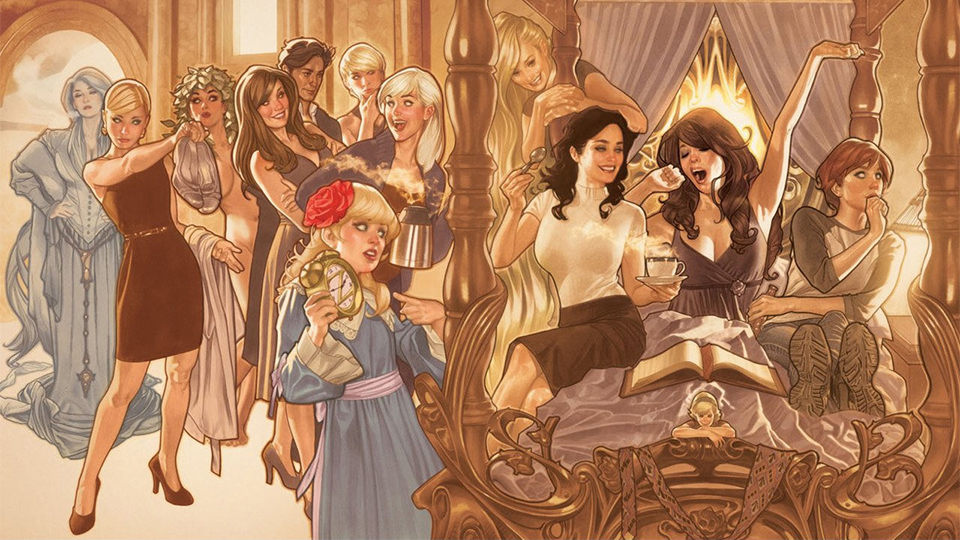
What about the other spin-offs?
Well, the other big one is called Fairest and follows the women of Fables — Sleeping Beauty, Rapunzel, Cinderella, The Snow Queen, Thumbelina, Snow White, etc. It ran for 30 issues and is a series of side stories that flesh out their histories.
How is it?
It’s good stuff. There are a lot of characters in the main series and it juggles them well for the most part. But sometimes, certain characters are forgotten about or left underdeveloped. This series is for them. It’s well worth reading.
Any other spin-offs?
Oh man, we haven’t even gotten started. There’s The Literals, Werewolves of the Heartland, The Last Castle, 1001 Nights of Snowfall, A Wolf in the Fold, Peter & Max: A Fables Novel, and the crossover with The Unwritten (another Vertigo series). If you’re hooked on Fables, they’re all worth reading; but if you don’t need anything more than the core story, it’s ok to pass on them.
And then there are the Cinderella stories.
Cinderella? Really?
You have no idea. From Fabletown with Love, Fables are Forever and Fairest: In All the Land are so much fun.
Hold up. “From Fabletown with Love” and “Fables are Forever.” You can’t mean…
Yep, Cinderella is the Fables version of James Bond.
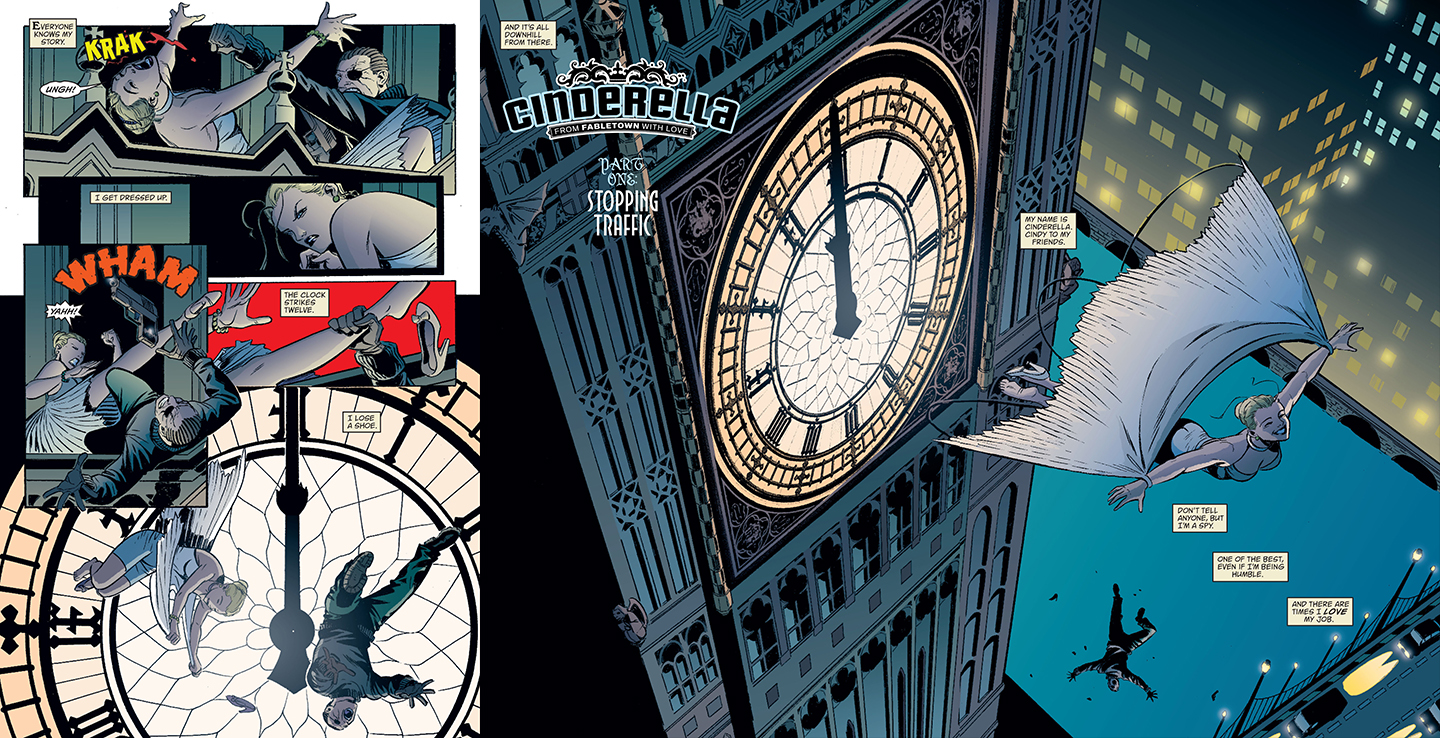
I don’t know how to feel about that.
Well, while the other inhabitants of Fabletown spent their years in exile mourning what they had lost, Cinderella divorced her deadbeat husband and spent the following 400 years making herself into, as she puts it, an excellent spy, a competent assassin, and a lousy diplomat. While most think of her as a dilettante and shoe store owner — with magic, technology, and immortality at her disposal — she is the greatest secret agent to ever live.
Her comics deal with her secret missions to save Fabletown from magical crises — before the Fables even know about them.
Not going to lie, that sounds pretty awesome.
That’s only because it is.
Alright, you’ve got me pumped. Also, intimidated. Where do I start this massive undertaking? Fables issue #1?
Don’t get me wrong, there’s nothing wrong with starting there, but I’d personally recommend starting with The Wolf Among Us — the Fables video game.
Really, the game?
Yeah, it takes place before the comics so you don’t have to worry about spoilers. Both interactive movie and point-and-click adventure, this game follows Bigby as he deals with Fabletown’s first ever fable murder — and has to dive deep into Fabletown’s seedy underbelly to solve the case.
I don’t know, man.
It’s a noir detective story where you play as the Big Bad Wolf hunting down a decapitating serial killer. What’s not to like?
OK, ok. I got it. Jeez.
One word of warning though — it is just as violent and sexually explicit as the comics… maybe even more so. Oh, and don’t expect the Bigby in the comic to act like the one you control in the game. Your choices will likely be far more aggressive than those of the Bigby of the comics would have been — I know mine were.
There is also a comic adaption of The Wolf Among Us, but I say go with the game if you can.
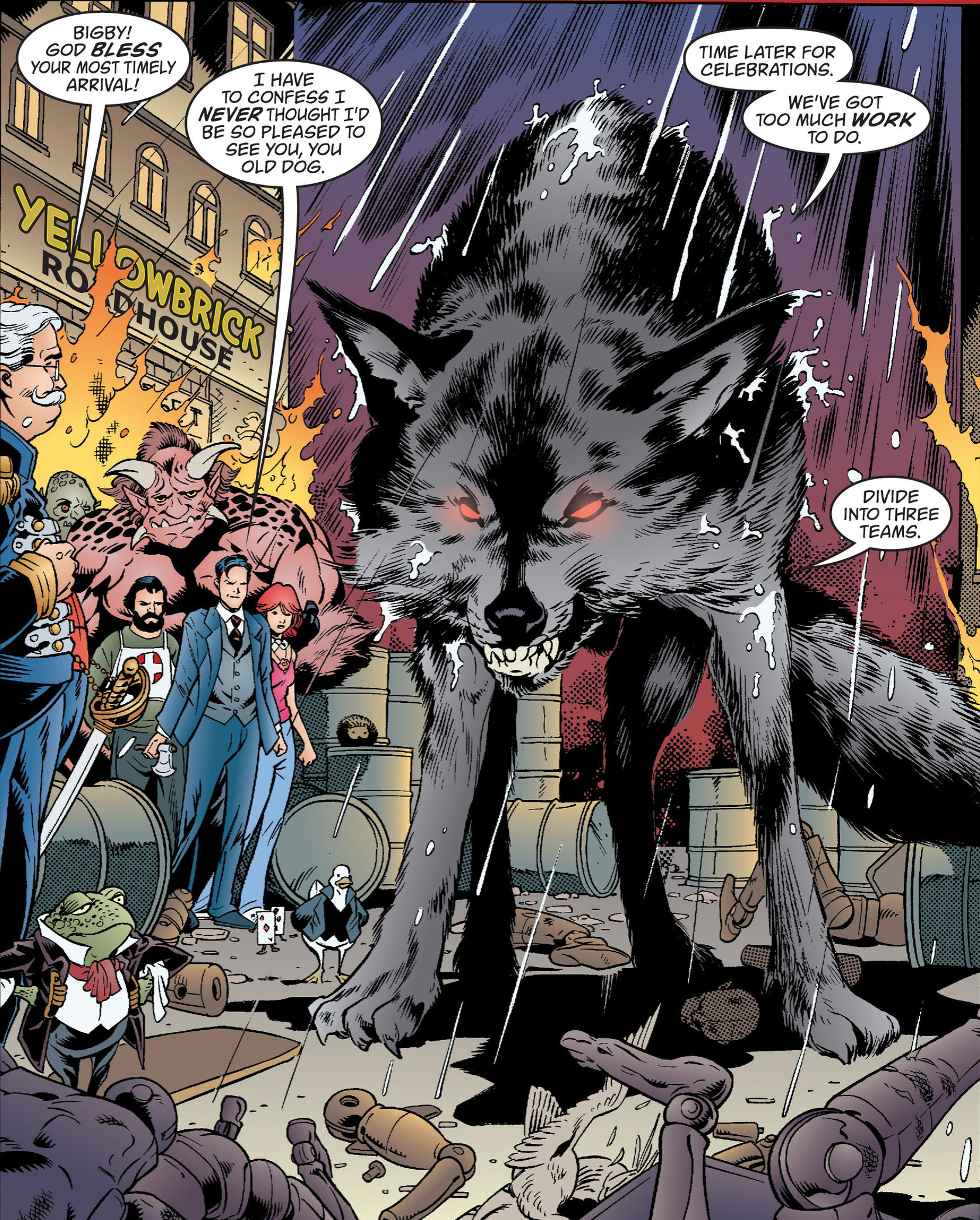
Alright, one last question. Let’s say I want to do the whole thing in chronological order. What should I do?
Well, if you are like me (read: “that insane”), this is the guide I used. It’s simple, easy to follow, and gives you a little bit of non-spoiler info about when each of the side stories can be safely read without encountering spoilers.
Sounds good.
So…
So?
Do I need to visit the local shrine and get an exorcism or are you gonna leave on your own?
Fine, fine! I get the hint. I’m so under appreciated.
And stay out!
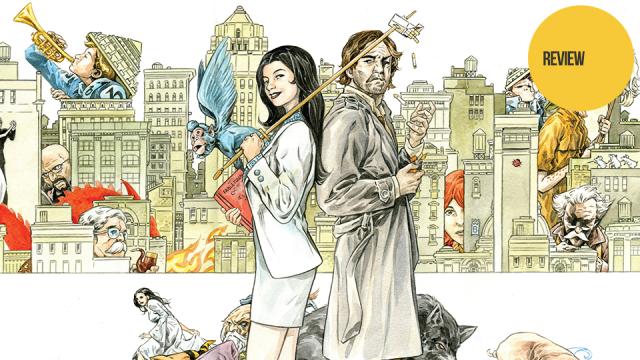
Comments
One response to “Fables: The Kotaku Comic Review”
Fables is bloody amazing.